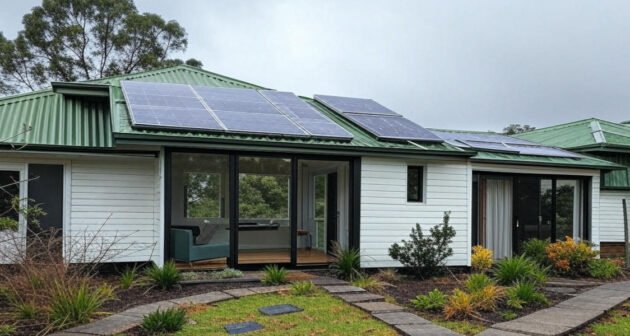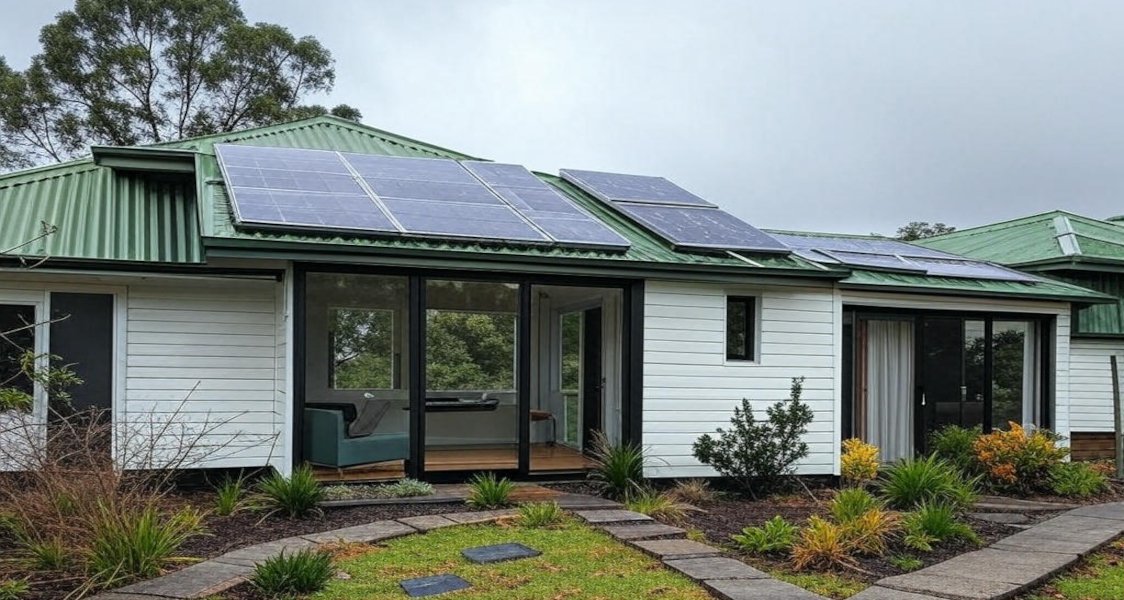
Title: Energy-Efficient Homes: Your Guide to Saving the Planet (and Your Wallet) Without Living in a Cardboard Box
“Design energy efficiency into your home at the start, and the benefits will pay off for years to come.”
Ah, the wisdom of yesteryear. Back when “energy-efficient home” meant stuffing newspaper into your walls and praying the furnace wouldn’t cough itself to death. Fast-forward to 2023, where we’ve swapped desperation for innovation, and “going green” no longer requires sacrificing your Netflix binge sessions. Let’s dive into the modern world of energy efficiency—where saving the planet is cool, your utility bills are smaller than your TikTok attention span, and your house might just outlive your student loans.
The Case for Efficiency: Why Your House Should Work Smarter, Not Harder
Study after study (and by “study,” we mean scientists in lab coats yelling “WHY ARE YOU STILL USING INCANDESCENT BULBS?!”) shows that energy-efficient homes can slash lifetime energy use by 50% or more. In Canada, that translates to savings of around 150,000overyourhome’slifespan.Butlet’sbereal:150,000overyourhome’slifespan.Butlet’sbereal:150k is also the price of a midlife-crisis Tesla, so why not invest in something that won’t make your neighbors roll their eyes?
With winter coming faster than a Game of Thrones plot twist, heating bills are about to skyrocket. But fear not! Modern energy-efficient homes are like that friend who brings a coat to a bonfire—prepared, cozy, and annoyingly smug about it.
2023’s Energy-Efficient MVP: The Thermal Envelope
Think of your home’s thermal envelope as its snuggie—a toasty barrier between you and Mother Nature’s mood swings. It includes walls, roofs, insulation, windows, and enough caulking to make Bob Vila weep with joy. Let’s break it down, 2023-style.
1. Wall & Roof Assemblies: From Tinder to Terminator
Gone are the days when “thick walls” just meant your house could double as a fallout shelter. Today’s builders are flexing with materials that would make Tony Stark jealous:
-
Structural Insulated Panels (SIPs): These bad boys are the PB&J of construction—layers of OSB and foam so thick, they’ll make your walls feel like a Yeti cooler. SIPs cut construction time faster than a TikTok dance trend and reduce errors because, let’s face it, humans are prone to “oops.”
-
Insulating Concrete Forms (ICFs): Imagine a concrete burrito wrapped in foam. ICFs are hurricane-proof, energy-efficient, and so sturdy they’ll probably survive the zombie apocalypse. Bonus: They’re perfect for passive-aggressive texts to your in-laws. (“Sorry, Karen, we can’t hear your comments about our ‘weird’ house—our walls are too insulated!”)
-
Mass Timber & CLT: Cross-laminated timber (CLT) is the eco-friendly cousin of concrete. It’s strong, sustainable, and gives your home a “I vacation in a Scandinavian forest” vibe.
2. Insulation: The Fluffier, The Better
Modern insulation has leveled up from pink fiberglass to space-age materials:
-
Aerogel: Nicknamed “frozen smoke,” this NASA-born material has an R-value of 10 per inch. It’s like wrapping your house in a cloud that moonlights as a superhero.
-
Vacuum Insulation Panels (VIPs): These panels suck out air (literally) to achieve R-values up to 50. Perfect for when you want your walls to double as a thermos.
Pro Tip: If your insulation isn’t thicker than your Aunt Linda’s Thanksgiving casserole, you’re doing it wrong. Aim for R-40+ in walls and R-60+ in attics.
3. Air/Vapor Barriers: Because Moisture is the Enemy
Nothing ruins a house faster than mold plotting a coup in your walls. Modern barriers use smart membranes that let moisture escape (like a breathable raincoat) while keeping air leaks locked down tighter than your Wi-Fi password.
Windows: The Eyes of Your Home (But Less Creepy)
The average home still loses 25% of its heat through windows, which is like heating your yard for no reason. But 2023’s windows are here to flex:
-
Triple-Glazed Windows: Three layers of glass, argon gas, and low-E coatings. They’re basically the Beyoncé of windows—flawless, expensive, and worth every penny.
-
Dynamic Glass: Electrochromic windows tint on command, blocking solar heat like sunglasses for your house. “Alexa, make my windows sassy.”
-
Frame Materials: Fiberglass and vinyl frames now outperform wood, laughing in the face of rot and warping.
Pro Tip: South-facing windows = free solar heat. North-facing windows = a great way to chill your leftovers. Use them wisely.
Controlled Ventilation: Breathe Easy, But Not Too Easy
Today’s airtight homes need to breathe smarter, not harder. Enter Heat Recovery Ventilators (HRVs) and Energy Recovery Ventilators (ERVs), which swap stale air for fresh air while salvaging 65% of the energy. They’re like a carpool lane for your HVAC system.
Warning: Skip the DIY ventilation. You don’t want your “fresh air” to include last night’s tuna casserole fumes.
Heating & Cooling: Size Matters (Smaller is Better)
Gone are the days of furnaces the size of a minivan. Modern homes use:
-
Heat Pumps: These all-in-one wonders heat and cool your home, sip electricity, and work in -25°C weather. They’re basically the Swiss Army knife of HVAC.
-
Geothermal Systems: Tap into the Earth’s steady 55°F temps. It’s like having a secret hot spring under your lawn.
-
Ductless Mini-Splits: Tiny, efficient, and perfect for zoning. No more fighting over the thermostat with your roommate who thinks 75°F is “chilly.”
Golden Rule: Bigger isn’t better. Oversized systems cycle on/off like a nervous tap dancer, wasting energy and your patience.
Energy-Efficient Gadgets: Because Tech Rules Everything
-
Smart Thermostats: Nest, Ecobee, and friends learn your habits and adjust temps automatically. They’ll even text you things like, “Why is the AC on? You’re in Bali.”
-
Solar Panels: Cheaper than ever, with sleek designs that won’t make your roof look like a sci-fi prop. Pair them with a Tesla Powerwall to store sunshine for rainy days.
-
ENERGY STAR Everything: Fridges, washers, dryers—look for the label. Your appliances should work harder than your excuses for not recycling.
Renewables: The Future is Bright (And Windy)
-
Solar Shingles: Tesla’s Solar Roof turns your house into a power plant without the aesthetic trauma of 2000s-era panels.
-
Community Solar: Can’t install panels? Buy into a solar farm. It’s like a timeshare, but without the regret.
-
Wind Turbines: For rural folks, small turbines can cut energy bills. Just don’t expect birds to RSVP to your block parties.
The Downsides: Yes, There Are a Few
-
Upfront Costs: Energy-efficient homes can cost 5–10% more to build. But with incentives like tax credits and green mortgages, you’ll recoup costs faster than your dog “recoups” your sandwich.
-
Builder Beware: Not all contractors speak “green.” Vet your team like you’re casting Ocean’s 14.
Final Thoughts: Your Home as a Climate Warrior
Building an energy-efficient home in 2023 isn’t just smart—it’s a middle finger to climate change. You’ll save money, live comfortably, and maybe even impress your hippie cousin at Thanksgiving. So go ahead: insulate like your Netflix subscription depends on it (it kinda does).
“We do not inherit the Earth from our ancestors; we borrow it from our children.” — Unless you’re reading this in 2073, in which case, sorry about the polar ice caps. Let’s build better.




